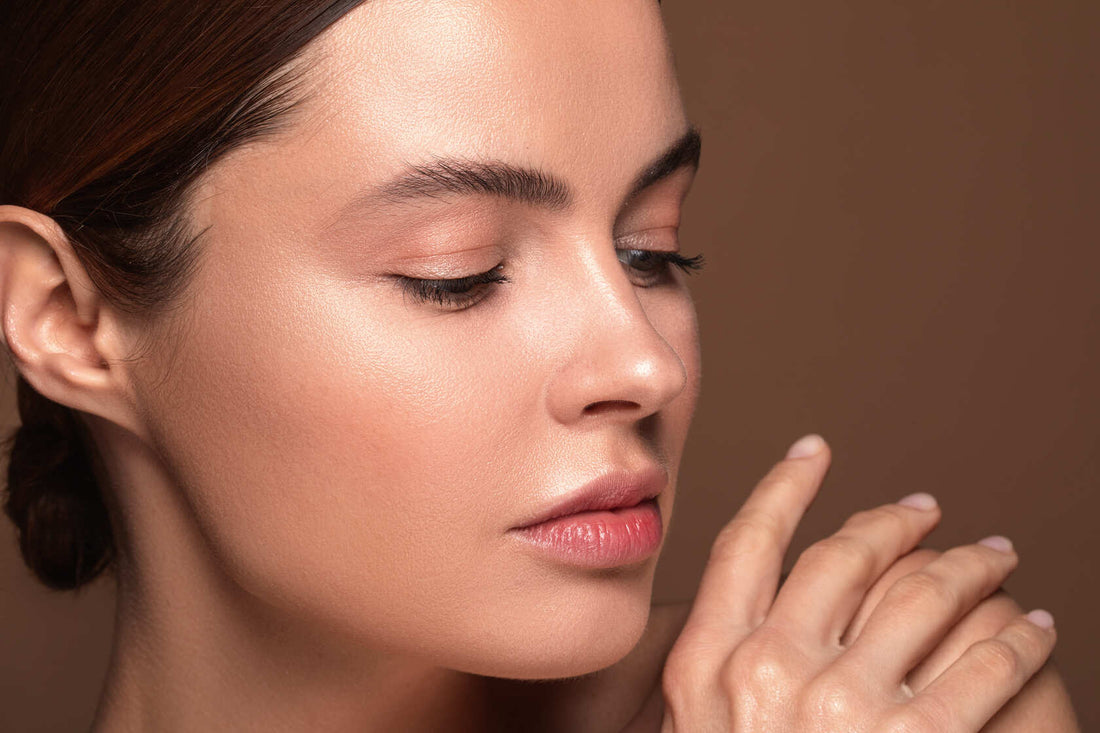
Best Ways To Heal Over Exfoliated Skin Fast And Restore Skin Glow
Written by Dr Shamsa Kanwal - Dermatologist
Updated on March 24th 2025
Does your skin feel tight, red, or extra sensitive? Instead of a radiant, healthy glow, are you dealing with irritation, peeling, or unexpected breakouts? If so, you might be facing a common skincare mistake—over-exfoliation.
Exfoliation is essential for smooth, vibrant skin, but too much of it can weaken your skin’s protective barrier, leading to dryness, inflammation, and increased sensitivity. When this barrier is compromised, the skin struggles to retain moisture and defend against external irritants—resulting in redness, peeling, and breakouts.
With the right approach, you can calm irritation, rebuild your barrier, and restore your skin’s health. This dermatologist-approved guide will walk you through how to fix over-exfoliated skin fast, plus expert tips to prevent it from happening again
Let’s dive in!
Understanding Over-Exfoliation: How It Affects Your Skin Barrier
Over-exfoliation occurs when the skin’s natural barrier is compromised due to excessive exfoliation, whether through harsh scrubs, potent chemical exfoliants, or a combination of exfoliating ingredients.
When this barrier is weakened, your skin loses essential moisture and becomes more vulnerable to environmental irritants. This often leads to redness, dryness, flaking, breakouts, and heightened sensitivity—the opposite of the smooth, radiant skin you were aiming for.
But don’t worry—your skin is resilient. With the right care, you can help it recover and regain its natural balance.
Why Over-Exfoliation Happens: Common Mistakes to Avoid
Over-exfoliation often results from common skincare mistakes that compromise the skin’s protective barrier. Recognizing and avoiding these mistakes can help maintain a healthy, resilient complexion.
-
Exfoliating Too Frequently:
Layering multiple exfoliating products—such as retinol, acids, and scrubs—can strip the skin’s natural barrier, resulting in redness, peeling, and breakouts. Overloading the skin with active ingredients disrupts its ability to repair and protect itself.

-
Using Harsh Exfoliants:
Physical scrubs with large, abrasive particles or high concentrations of chemical exfoliants can cause microtears and inflammation, making the skin more reactive over time. Gentle, well-formulated exfoliants are key to maintaining skin health without causing damage.
- Combining Too Many Exfoliants:
Layering multiple exfoliating products—such as retinol, acids, and scrubs—can strip the skin’s natural barrier, resulting in redness, peeling, and breakouts. Overloading the skin with active ingredients disrupts its ability to repair and protect itself.
Symptoms and Signs of Over-Exfoliated Skin
Over-exfoliation can mimic conditions like eczema or rosacea, making it essential to recognize early warning signs to prevent further damage. Here’s how to tell if you’ve over-exfoliated:
-
Redness And Irritation:
If your skin appears flushed, feels warm, or stings after exfoliation, it may be a sign of barrier damage. Over-exfoliation strips away protective lipids, leading to heightened sensitivity, redness, and inflammation [1]. -
Tightness and Dryness:
Healthy skin maintains a balance between exfoliation and hydration. Over-exfoliation removes essential oils from the skin, leaving your skin parched and unable to retain moisture [2]. This results in tightness, dryness, and discomfort. In severe cases, flaking or peeling may also occur. -
Increased Sensitivity :
Over-exfoliation can damage your skin barrier [3]. A compromised skin barrier makes previously tolerated skincare products feel harsh or irritating. You may notice a stinging or burning sensation even when using mild cleansers or moisturizers—indicating that your skin is in distress [4]. -
Breakouts and Peeling :
Excessive exfoliation can disrupt the skin’s oil production, leading to an overproduction of sebum and clogged pores, which may trigger breakouts [5]. Some individuals also experience peeling and flaking, further signaling barrier damage.If you notice any of these symptoms, stop exfoliating immediately and focus on repairing your skin. Here’s a summary of the difference between healthy exfoliation and over-exfoliation:

The Science Behind Skin Recovery: How Your Skin Repairs Itself
The skin is a self-renewing organ with a built-in repair system designed to restore damage over time [6]. When over-exfoliation compromises the skin barrier, the body activates its natural healing mechanisms to rebuild and strengthen the outermost layer, the stratum corneum, which acts as a shield against environmental stressors [7].
To repair this barrier, the skin produces essential lipids—ceramides, fatty acids, and cholesterol—which help restore its protective function and lock in moisture. Hydration and collagen production also play a critical role in the recovery process, keeping the skin resilient and plump.
Using barrier-repairing ingredients can speed up this recovery. Sharohyal Snail Veg, Squalane, and Saccharide Isomerate deeply hydrate and support your skin’s healing process, helping it bounce back faster and regain its healthy glow.
How to Fix Over-Exfoliated Skin: Immediate Steps To Take
If you’ve over-exfoliated, don’t panic! Your skin has the ability to heal with the right care. Understanding how to treat over-exfoliated skin is essential for promoting faster recovery. Follow these essential steps to nourish and restore your skin effectively.
-
Stop Exfoliating Immediately :
Give your skin time to heal by discontinuing the use of exfoliants, including chemical acids (AHAs, BHAs, PHAs), scrubs, and retinoids. Avoid harsh treatments for at least 2–4 weeks, and wait until your skin has been consistently calm for at least a week before reintroducing exfoliation. -
Use Cool Water to Cleanse :
Hot water can exacerbate irritation and further dehydrate the skin. Instead, cleanse your face with lukewarm or cool water to minimize inflammation. Choose a gentle, hydrating cleanser containing Saccharide Isomerate, SyriCalm, or Peachcalm to maintain moisture balance.
Even if a cleanser feels mild, it can still contain comedogenic ingredients that slow healing. Check your skincare products using our pore clogger checker tool to stay barrier-safe, especially when your skin is vulnerable and in recovery mode.
-
Apply a Soothing Treatment :
Calm irritation with anti-inflammatory ingredients such as SyriCalm and Unisooth ST-32. These ingredients help reduce redness and inflammation. Opt for lightweight, non-comedogenic formulas that absorb easily without clogging pores. -
Avoid Active Ingredients :
Active ingredients can worsen irritation when the skin barrier is compromised. Eliminate AHAs (glycolic acid, lactic acid), BHAs (salicylic acid), and retinoids (retinol, tretinoin) from your skin care routine completely as they can intensify inflammation and increase the risk of long-term side effects. Instead, focus on hydrating and barrier-repairing ingredients like Sharohyal Snail Veg, Squalane, and Saccharide Isomerate.
Long-Term Healing Process of Skin
Effective skin recovery goes beyond immediate relief—long-term care is essential to fully restore moisture, repair the skin barrier, and prevent further damage. Incorporate these steps into your routine to promote sustained healing and resilience.
-
Replenish Hydration with Barrier-Strengthening Moisturizers :
A compromised skin barrier loses moisture rapidly, leading to dryness, flaking, and irritation. To replenish hydration, use a rich, fragrance-free moisturizer containing Peachcalm, SyriCalm, and Squalane, which help restore the skin’s lipid barrier and improve moisture retention. Apply moisturizer morning and night, and reapply as needed throughout the day—especially if your skin feels tight or dry.
-
Shield Your Skin from Sun :
Over-exfoliated skin is highly sensitive to UV exposure, which can worsen inflammation and delay healing. Apply a broad-spectrum SPF 50+ sunscreen daily, even when indoors. Opt for a mineral-based sunscreen with zinc oxide or titanium dioxide, as these are less likely to cause irritation compared to chemical sunscreens. When outdoors, limit direct sun exposure and reapply sunscreen every two hours to ensure continuous protection..
-
Repair and Strengthen the Skin Barrier :
Once the initial irritation subsides, focus on long-term barrier repair to restore the skin’s ability to retain moisture and defend against external aggressors. Key ingredients such as SYN-AKE, Niacinamide, Saccharide Isomerate, Peachcalm, Squalane and Sharohyal Snail Veg help replenish essential lipids, soothe inflammation, and reinforce the skin’s protective layer. Integrating these barrier-supporting ingredients into your routine can accelerate recovery, prevent future damage, and maintain overall skin health.
If you're ready to reintroduce a calming, brightening serum that repairs your barrier, Rush Hour Serum is powered by our proprietary GLOW7™ blend and gentle enough for recovery routines. This lightweight serum for sensitive skin offers gentle, targeted support. It contains clinically backed actives including BV-OSC (a stable form of Vitamin C), Saccharide Isomerate, and SEPIBLISS FEEL, making it a go-to for soothing post-exfoliation irritation while restoring glow.
How To Prevent Over-Exfoliation in the Future
To maintain healthy skin while reaping the benefits of exfoliation, it’s essential to tailor your routine to your skin’s needs. Over-exfoliation can be avoided by introducing exfoliants gradually, using the right products, and ensuring proper skin hydration and recovery.
Safely Reintroducing Exfoliation into Your Routine
Once your skin has fully recovered, a slow and controlled approach is crucial to prevent another cycle of over-exfoliation. Here’s how to do it the right way:
-
Start Slow:
Begin exfoliating once or twice a week, then gradually adjust based on your skin’s tolerance. Monitor for redness, peeling, or irritation before increasing frequency.
-
Avoid Combining Exfoliating Ingredients:
Using multiple exfoliants simultaneously—such as AHAs, BHAs, retinoids, and physical scrubs—can compromise the skin barrier. Stick to one exfoliant at a time to prevent excessive irritation.
-
Always Follow with Hydration & Barrier Support:
Always pair exfoliation with barrier-repairing ingredients like SYN-AKE, Niacinamide, Saccharide Isomerate, Peachcalm, Squalane and Sharohyal Snail Veg to maintain a healthy skin barrier and minimize sensitivity.
-
Incorporate Rest Days:
Exfoliation should not be a daily step. On non-exfoliation days, focus on hydration, nourishment, and barrier repair. Pay attention to early warning signs of over-exfoliation —redness, tightness, or increased sensitivity—and adjust accordingly.
Here’s a table simplifying exfoliation frequency recommendations based on different skin types:
| Skin Type | Recommended Exfoliation Frequency | Best Exfoliant Type |
|---|---|---|
| Oily & Acne-Prone | 1–2 times per week | Gentle physical exfoliants (e.g., rice bran powder) |
| Normal/Combination | 1–2 times per week | Gentle physical exfoliants or enzymes (e.g., jojoba beads, papaya enzymes) |
| Dry or Sensitive | Once a week or less | Enzymes (e.g., papaya, pineapple, pumpkin) |
| Mature Skin | 1–2 times per week | Gentle physical exfoliants or enzymes (e.g., oatmeal, pumpkin enzymes) |
Seasonal Adjustments: Reduce exfoliation in colder months when the skin tends to be drier, and slightly increase it in warmer months when oil production is higher.
When To See A Dermatologist?
If your skin does not improve despite gentle care and proper exfoliation adjustments, it’s important to seek professional guidance. Consult a dermatologist if you experience:
- Persistent peeling, burning, or swelling
- Signs of infection, such as pus or extreme redness
- No improvement after two weeks of a barrier-repairing routine
A dermatologist can assess your skin’s condition, recommend personalized treatments, and guide you toward safe exfoliation practices.
FAQS About Over-Exfoliated Skin
Here are answers to some of the most common questions about over-exfoliation and skin recovery.
1. Can skin recover from over-exfoliation?
Yes, the skin can heal from over-exfoliation with proper care. Recovery time depends on the severity of damage, but in most cases, the skin barrier restores itself within a few weeks when given hydration, protection, and rest.
2. How long does it take for over-exfoliated skin to heal?
Healing time varies based on severity:
- Mild cases (slight redness or dryness): 5–7 days
- Moderate cases (redness, peeling, irritation): 2–3 weeks
- Severe cases (burning, swelling): 1 month or longer
To speed up healing: stop exfoliating, use barrier-repairing ingredients (SYN-AKE, Niacinamide, Saccharide Isomerate, Peachcalm, Squalane and Sharohyal Snail Veg) and avoid actives like Retinoids or Acids.
3. Can over-exfoliation cause permanent damage?
Occasional over-exfoliation won’t cause permanent damage, but frequent or severe over-exfoliation can lead to:
- Chronic sensitivity (skin becomes reactive to products it once tolerated)
- Persistent redness or uneven skin tone
- Weakened barrier, making skin prone to dehydration and irritation
To prevent long-term effects, adopt a balanced exfoliation routine, give the skin rest days, and prioritize barrier-repairing ingredients.
4. Is Vaseline good for over-exfoliated skin?
Vaseline (Petrolatum) can be beneficial for severely dry, irritated, or peeling skin because it forms a protective barrier that locks in moisture, aiding the healing process. However, it does not provide hydration, so it should be paired with a hydrating serum or moisturizer for best results.
- Vaseline is best for: Very dry, peeling, or compromised skin that needs a protective barrier.
- Vaseline is not ideal for: Oily or acne-prone skin, as it may feel too heavy or clog pores.
For lighter alternatives, try Sachharide Isomerate or Squalane creams, which restore the skin barrier without occlusion.
5. What is the fastest way to heal over exfoliated skin?
The fastest way to heal over-exfoliated skin is to immediately stop exfoliating and focus on repairing the skin barrier with hydration and soothing ingredients. Follow these steps for a faster recovery:
- 1. Discontinue Exfoliants & Actives: Avoid AHAs, BHAs, retinoids, and scrubs for at least 2–4 weeks.
- 2. Use a Gentle Cleanser: Wash your face with a mild, non-foaming cleanser and cool water. The cleanser should contain ingredients like Saccharide Isomerate, SyriCalm, or Peachcalm to help maintain the skin's moisture balance.
- 3. Apply a Barrier-Repair Moisturizer:Use a fragrance-free, nourishing moisturizer with Peachcalm, SyriCalm, and Squalane to replenish hydration and strengthen the skin barrier.
- 4. Use Anti-Inflammatory Ingredients: Incorporate anti-inflammatory ingredients like SyriCalm and Unisooth ST-32 to calm redness and irritation.
- Protect with Sunscreen: Over-exfoliated skin is more vulnerable to UV damage. Use a broad-spectrum SPF 50+ mineral sunscreen (zinc oxide or titanium dioxide).
- 6. Avoid Harsh Skincare Products: Stay away from alcohol-based toners, essential oils, or fragranced products, as they can worsen irritation.
With these steps, mild cases may heal within a week, while more severe over-exfoliation can take 2–4 weeks for full recovery. Be patient and gentle with your skin during this time.
6. Can over-exfoliating cause acne?
Yes, over-exfoliating can trigger acne due to barrier damage and disrupted oil production. Here’s how:
- Increased Oil Production: Over-exfoliation strips away natural oils, leading to compensatory excess sebum that clogs pores.
- Weakened Skin Barrier: A compromised barrier makes skin more susceptible to bacteria and breakouts.
- Inflammation & Sensitivity: Over-exfoliated skin becomes inflamed and irritated, which can worsen existing acne or lead to breakouts.
To prevent acne from over-exfoliation, reduce exfoliation frequency, use gentle exfoliants, and prioritize hydration and barrier repair.
Conclusion
Over-exfoliation can leave the skin sensitive, inflamed, and vulnerable, but with the right care, recovery is possible. The first step is to stop exfoliating immediately and focus on soothing and hydrating the skin. Using barrier-repairing ingredients like SYN-AKE, Niacinamide, Saccharide Isomerate, Peachcalm, Squalane and Sharohyal Snail Veg can help restore the skin’s protective function. Sunscreen is essential to prevent further damage, as over-exfoliated skin is more prone to sun sensitivity.
Preventing over-exfoliation starts with moderation and understanding your skin’s needs. Adjusting exfoliation frequency, avoiding harsh combinations, and giving the skin time to heal between treatments can help maintain a balanced, healthy complexion. If symptoms persist for several weeks or worsen despite gentle care, consulting a dermatologist is recommended for professional guidance.
References
https://www.academia.edu/download/88419089/Article_11._Skin_Care_with_Exfoliation..pdf
https://d1wqtxts1xzle7.cloudfront.net/88419089/Article_11._Skin_Care_with_Exfoliation.-libre.pdf
https://afre.org/7-reasons-why-your-skin-is-suddenly-very-sensitive.html
https://www.dermascope.com/skin-care/10296-alpha-beta-enzymes-the-science-of-chemical-exfoliation

 Hydration
Hydration
 Soothing
Soothing
 Radiance
Radiance
 Clarity
Clarity









